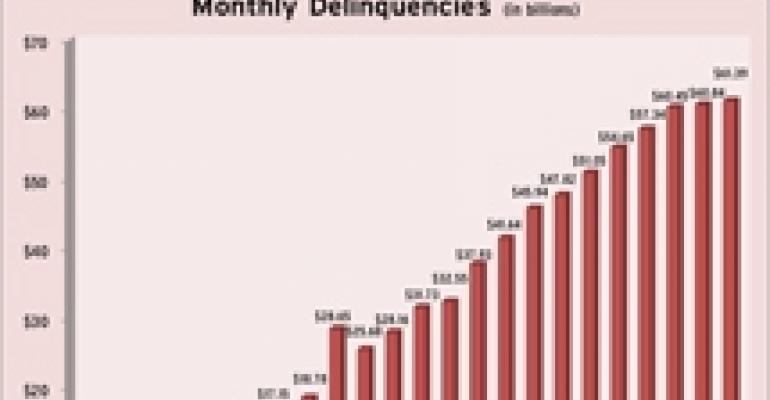Delinquencies on CMBS loans continued to increase in recent months, according to the most recent reports from Trepp LLC and Realpoint LLC, two research firms that track the sector.
In August, the delinquent unpaid balance for CMBS rose $551.8 million, up to $61.39 billion from $60.84 billion a month prior, according to Horsham, Pa.-based Realpoint. The increase was greater than the one posted in July, when the unpaid balance rose just $387.9 million. The rise, however, was still smaller than the average for the first six months of 2010 when delinquencies grew by an average of $3.14 billion per month.

Outside of a $1.37 billion decrease in the 90+-day category, the remaining four delinquency categories each increased, fueled by further delinquency degradation and credit deterioration. On the other hand, with ongoing loan liquidations, modifications and resolutions, the distressed 90+-day, foreclosure and REO categories as a whole fell for the first time in almost three years – down by $496 million (1 percent) from the previous month. That snapped a string of 31 straight monthly increases.
The total unpaid balance for CMBS pools reviewed by Realpoint for the August remittance was $773.98 billion, down from $780.97 billion in July 2010.
The delinquency ratio for August of 7.93 percent (up from the 7.79 percent reported for July) is more than two times the 3.47 percent reported in August 2009 and more than 28 times the Realpoint recorded low point of 0.28 percent in June 2007.
Realpoint lowered its projection for the delinquent unpaid CMBS balance, which it expects to reach between $70 billion and $80 billion by the end of 2010—a $10 billion decrease from its previous projection. The firm also projects the delinquency percentage to reach between 9 percent and 10 percent by the end of the year.
By property type, in August, multifamily loans topped retail loans as the greatest contributor to overall CMBS delinquency for the third straight month. Retail loans had been the greatest contributor for six straight months prior to June. Delinquent multifamily loans account for 2.0 percent of the CMBS universe and 25.0 percent of total delinquency. The retail default rate decreased slightly to 6.4 percent, down from 6.6 percent in July and up from 3.9 percent one year ago. In its monthly report, Realpoint wrote, “For the remainder of 2010, we still consider retail delinquency a legitimate concern as commercial real estate lags the economy, and consumer spending continues to suffer from the experienced decline. We also cannot rule out additional store closings and potential retailer bankruptcies (most likely at a slower pace), along with growing balloon maturity default risk.”
Meanwhile, in its monthly report, Trepp said that the CMBS delinquency rate had reached a record 9.05 percent in September, up from 8.92 percent in August. The 13 basis point increase was smaller than the 21 basis point increase posted from July to August, and is lower than the average jump of 33 basis points per month posted over the previous 12 months.
The delinquency rate one year ago was 4.36 percent. The 30+ day delinquency rate on retail jumped from 6.76 percent in August to 7.13 percent in September. It is the first time the delinquency rate for the sector has surpassed 7 percent, according to Trepp.
After closing the gap with office and industrial properties in August, the September increase put some distance between the property sectors. The delinquency rate for industrial properties fell from 6.56 percent to 6.48 percent and rose for office properties from 6.57 percent to 6.62 percent. The lodging (19.33 percent) and multifamily (14.43 percent) sectors remain the most severely distressed, according to Trepp’s figures.


